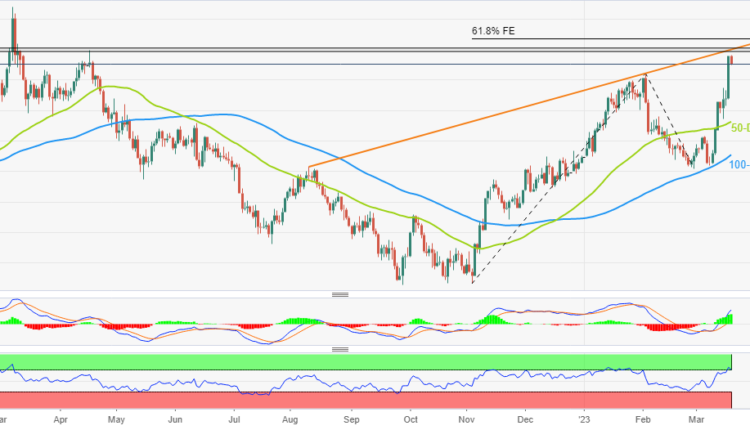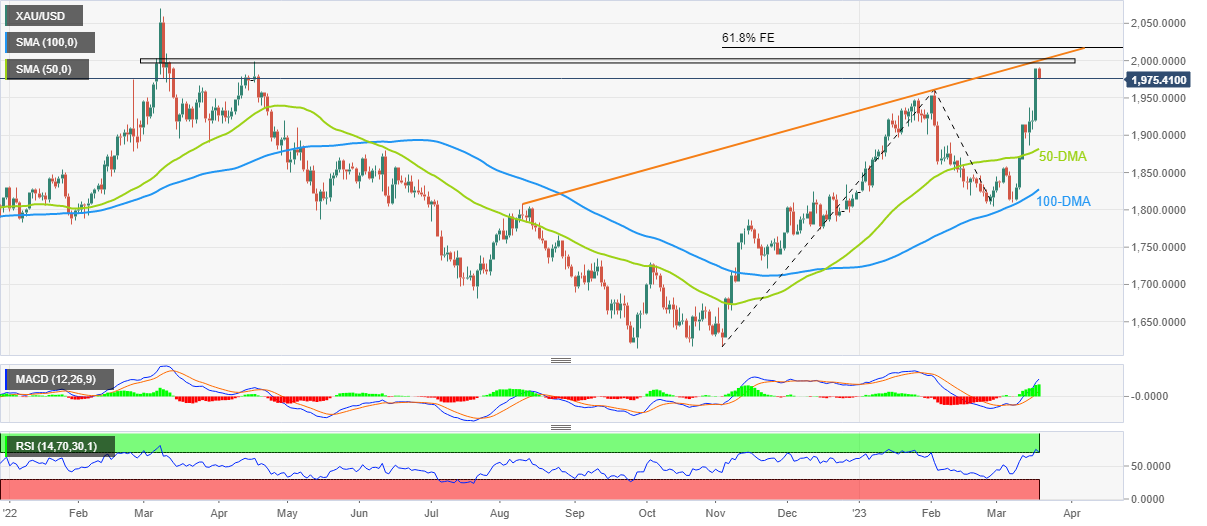XAU/USD retreats towards $1,960 as yields rebound, Federal Reserve eyed
- Gold price reverses from the highest levels in 2023 after posting a notable jump.
- Joint central bank actions to propel US Dollar liquidity, UBS-Credit Suisse deal enable United States Treasury bond yields to recover.
- Federal Reserve’s reaction to banking sector turmoil will be crucial for the Gold price.
- XAU/USD traders should also observe preliminary readings of March month Purchasing Managers’ Index.
Gold price (XAU/USD) takes offers from the Year-To-Date (YTD) high while targeting the previous resistance surrounding $1,960, near $1,976 by the press time of early Monday in Asia. In doing so, the precious metal pares the recent losses after posting the biggest daily and weekly jump in three years in the last.
The latest recovery in the United States Treasury bond yields, backed by hopes of more liquidity in the market, seems to have underpinned the US Dollar rebound and weighs on the Gold price. Also challenging the XAU/USD bulls is traders’ anxiety as the key week comprising the Federal Reserve (Fed) monetary policy announcements begins. That said, the yellow metal’s previous fall could be linked to a slump in the bond coupons across the board amid fears of the return of the 2008 financial market crisis.
Gold price swiftly reacts to Treasury bond yields’ moves
Gold price drops on the latest recovery in the United States Treasury bond yields amid news suggesting no liquidity crunch moving ahead. That said, Sky News reported the news of the UBS-Credit Suisse takeover on Sunday evening while stating that UBS will pay 3 billion Swiss francs (£2.6bn) to acquire Credit Suisse. The news further adds that UBS has agreed to assume up to 5 billion Francs (£4.4bn) in losses, and 100 billion Swiss Francs (£88.5bn) in liquidity assistance will be available to both banks.
On the same line were the comments from the US Federal Deposit Insurance Corporation (FDIC) mentioning that the deposits of Signature Bridge Bank will be assumed by a subsidiary of New York Community Bancorporation. Furthermore, the Bank of Canada, Bank of England, Bank of Japan, European Central Bank, Federal Reserve, and Swiss National Bank are all up for announcing joint actions to provide more liquidity via standing US dollar liquidity swap line arrangements. It should be noted that the previously downbeat Treasury bond yields could be linked to the trader’s rush to risk safety amid the market’s turmoil, as well as hopes of interest rate cuts from major central banks late in 2023.
Talking about the market turmoil, the early challenges to the banking sector emanating from the Silicon Valley Bank (SVB) and Signature Bank joined the Credit Suisse saga, as well as the First Republic Bank, to highlight a full-blown Déjà vu for the 2008 crisis. The same joined downbeat US data to shift traders’ attention toward the Treasury bonds and Gold to safeguard their investments amid volatile markets.
During the last week, the US Consumer Price Index (CPI) for February matched 6.0% YoY market expectations versus 6.4% prior while the Retail Sales also marked -0.4% MoM figure versus -0.3% expected and 3.2% previous readings. Further, US Consumer Confidence per the University of Michigan's (UoM) Consumer Confidence Index dropped to 63.4 for March versus 67.0 expected and prior. The details suggest that the year-ahead inflation expectations receded from 4.1% in February to 3.8%, the lowest reading since April 2021, while the 5-year counterpart dropped to 2.8% from 2.9% previous reading. Furthermore, US Industrial Production remained unchanged in February versus 0.2% expected and January's 0.3% (revised from 0%) expansion.
In addition to the downbeat US data, mixed statistics from China, the world’s second-largest economy, also raised market fears and allowed the Gold price to remain firmer. It should be noted that the stocks in Europe and Asia portrayed a risk-off mood but those in the US gained in the last week.
That said, United States two-year Treasury bond yields marked the biggest weekly loss in three years while the 10-year counterpart dropped the most since early January. However, the latest readings suggest that the US 10-year Treasury bond yields rose four basis points (bps) to 3.47% while the two-year counterpart rises to 3.98%.
Given the latest action in the bond markets, Gold traders should closely watch yields for better directions.
Federal Reserve could make or break XAU/USD
While the recent hopes of more liquidity in the market seemed to have weighed on the Gold price, the metal isn’t out of the woods as traders remain cautious over the banking sector crisis. Also challenging the XAU/USD traders are the multiple central banks' decisions, including the US Federal Reserve (Fed), lying ahead.
It should be noted that the Fed is up for a 0.25% rate hike on Wednesday but the rate lift isn’t crucial as it’s mostly priced in. More important is the Fed’s outlook on the banking sector and the US economy, as well as the rate hike trajectory, moving forward. Should the US central bank sounds cautious on future rate hikes, or pauses the current one, the odds of a rally in the Gold price can’t be ruled out. However, hawkish comments from the Fed won’t hesitate to trigger the XAU/USD’s slump.
Other central banks, PMIs and banking sector updates are important too
Apart from the Federal Reserve, monetary policy meetings of the Swiss National Bank and Bank of England (BoE) will also be important for Gold traders to watch as the central bank’s outlook for the latest banking sector fallout becomes crucial. Also important are the preliminary readings of the March month PMIs. Above all, risk catalysts and the United States Treasury bond yields will be the key for Gold traders to watch for clear directions.
Also read: Gold Price Weekly Forecast: $2,000 back in crosshairs amid market turmoil
Gold price technical analysis
Gold price refreshed the YTD high on Friday, after successfully crossing February’s peak surrounding $1,960.
The upside momentum, however, lacked support from the Relative Strength Index (RSI), placed at 14, as the line touched the overbought territory and poked XAU/USD bulls afterward.
Also challenging the Gold price upside are multiple resistances between $1,996 and the $2,000 threshold, comprising an ascending trend line from August 2022 and an area including levels marked during March and April of 2022.
Even if the Gold price crosses the $2,000 hurdle, the 61.8% Fibonacci Expansion (FE) of the metal’s run-up from November 2022 to February 2023, around $2,017, could act as the last defense of the XAU/USD bears.
That said, a clear upside break of $2,017 won’t hesitate to challenge Gold buyers targeting the previous yearly top of $2,070.
On the flip side, Gold sellers aim for the previous monthly top surrounding $1,960, a daily closing below the same can trigger a short-term downside of the metal.
In that case, the $1,900 threshold and the 50-DMA support of around $1,880 could gain the market’s attention.
It’s worth noting, however, that the 100-DMA level near $1,824 and the $1,800 round figure act as strong supports for the Gold price.
Overall, Gold buyers are likely to occupy the driver’s seat but the road towards the north appears bumpy unless crossing the $2,017 hurdle.
Gold price: Daily chart
Trend: Limited upside expected



Comments are closed.